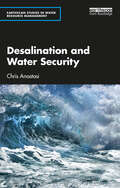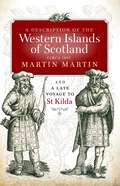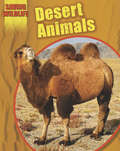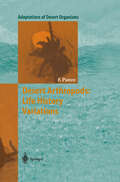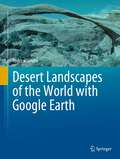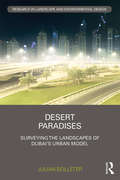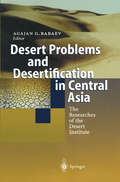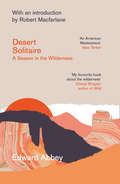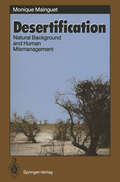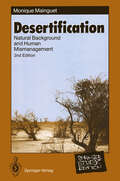- Table View
- List View
Desalination and Water Security (Earthscan Studies in Water Resource Management)
by Chris AnastasiDesalination is to the water industry what renewables are to the electricity sector. However, unlike renewables, the former is being deployed in a quiet revolution away from public glare. This book provides a holistic view of desalination, highlighting the important role this technology can play in providing safe access to water across the globe. It describes the context for this technology to flourish in the coming decades. It discusses the pressures on freshwater resources and the key role the desalination industry plays as it moves from a good-to-have provider today to a must-have mainstream water solution in the future. The book explores the vital elements of the desalination industry, including the winning technologies and how further technological developments will reduce costs and increase deployment into new areas. It also addresses the energy used and the key environmental issues of carbon dioxide emissions and brine waste production. Using a series of country case studies, the book illustrates how desalination can supplement natural water resources in different environments and for different purposes, and how it is supporting domestic and economic activity. Providing a forward-thinking assessment, the book considers developments over the next 30 years as climate change impacts become even more apparent. This book will be of great interest to those working to alleviate water scarcity and improve water security. It will also be of interest to those in water resource management, water policy and regulation, water science, and environmental engineering.
Desalination Concentrate Management (SpringerBriefs in Molecular Science)
by Bradley Ladewig Benjamin AsquithThis book examines five methods used for concentrate management, namely; disposal to surface water, disposal to sewerage, deep well injection, land applications and evaporation ponds. In particular, the book focuses on the design, siting, cost, and environmental impacts of these methods. While these methods are widely practiced in a variety of settings already, there are many limitations that restrict the use of certain disposal options in particular locations.
Description Approaches and Automated Generalization Algorithms for Groups of Map Objects
by Haowen YanThis book focuses on the generalization of map features, providing descriptions and classifying groups of map objects into six categories: point clusters, groups of contours, road networks, river networks, continuous areal features and discrete areal features. Discussing the methods and algorithms in map generalization in equal measure, it also describes the approaches for describing map features. The book is a valuable reference for graduates and researchers who are interested in cartography and geographic information science/systems, especially those in automated map generalization and spatial databases construction.
A Description of the Western Isles: Circa 1695
by Martin Martin Donald MonroIt is three hundred years since Martin Martin’s great journey around the Western Isles, Orkneys and Shetlands. The first and one of the greatest of all travellers in Scotland, Martin is also unique in being the only native Gaelic speaker amongst them. A Description of the Wester Isles is a unique and authoritative resonance which makes it, even today, a mine of information on the history, customs, traditions and life of the Hebrides. It also casts light on the islands during a crucial period of history when the old structures of society still held sway before Jacobite rebellions altered society irrevocably.
Desert Aeolian Processes
by V.P. TchakerianThe idea for this volume came during the dryland sessions of the Association of American Geographers meeting in San Diego in April, 1992. The large number of papers devoted to aeolian processes and landforms indicated to me that aeolian geomorphology had come of age and the last 15 years or so had produced a plethora of papers, books, and edited volumes on all aspects of aeolian geomorphology. Chapter one is my tentative attempt to place develop ments in aeolian geomorphology in a historical perspective and to contemplate some thoughts about the future. The fourteen papers selected address a wide range of issues ranging from micro-scale studies devoted to aeolian dust, sediment transport, and rock varnish in ventifacts to medium-scale studies of dunes and dune forms, reverse desertification, and macro-scale studies of ergs and sand transport pathways. The American Southwest, particularly the spectacular and unique Mojave Desert of California, is featured prominently in seven chapters. I hope this volume provides students and colleagues some new perspectives in aeolian geomorphology as well as pathways for future work.
Desert Animals (Saving Wildlife)
by Sonya NewlandDesert Animals explains how some of the world's most unusual creatures have come under threat and what we are doing to save the extreme desert environment in which they live.It is part of the Saving Wildlife series, which investigates the world's endangered species in the context of their different environments.
Desert Arthropods: Life History Variations (Adaptations of Desert Organisms)
by Fred PunzoIt is difficult for me to recollect a time when I was not fascinated with the very notion of a desert. Walt Disney's film, The Living Desert, which I initially saw when I was 8 years of age, provided me with my first glimpse of this wondrous yet seemingly ho stile environment. The images were hypnotic and captivating. I looked on in amazement at the promenade Cl deux of the male and female scorpions during courtship. Their rhythmic and coordinated movements as they grasped one another made them appear to glide in unis on over the surface of the sand, each individual totally absorbed with its partner. In the next minute the fern ale had suddenly and utterly transformed herself like some Jekyll and Hyde act, into an aggressive predator whose prior gregarious embrace was now a hold of death for the male. The indomitable desert grasshopper mouse, the ever sentient kit fox, the graceful shovel-nosed snake swimming in an endless sea of sand.
Desert Development: Man and Technology in Sparselands (GeoJournal Library #4)
by YehudaGradusThe fact that approximately one-third of the world's land mass is arid desert may be congenial for the camel and the cactus, but not for people. Nevertheless, well over half a billion people, or 15% of the world's population live in arid desert areas. If the world's population were distributed evenly over the land surface, we would expect to find about 30% of the population inhabiting arid desert areas. Does the fact that 'only' 15% of the world's population live in an arid desert environment reflect the harshness of the environment? Or is it a testimony to the adaptability and ingenuity of mankind? Do we view the glass as half-full? Or half-empty? The contributors to Desert Development: Man and Technology in Sparselands adopt the position that the cup is half-full and, in fact, could be filled much more. Indeed, many arid desert zones do thrive with life, and given appropriate technological develop ment, such areas could support even greater popUlations. While the dire Malthusian prediction that rapid world population growth exceeds the carrying capacity of existent resource systems has gained popularity (typified by the 1972 Club of Rome book, Limits to Growth), there is a growing body of serious work which rejects such pessimistic 'depletion' models, in favor of models which are mildly optimistic.
Desert Dust in the Global System
by Andrew S. Goudie Nicholas J. MiddletonDust storms are a vital component of the environment. This book explores and summarises recent research on where dust storms originate, why dust storms are generated, where dust is transported and deposited, the nature of dust deposits and the changing frequency of dust storms over a range of time-scales. It is the first global study of causes and effects of dust storms, which are one of the increasing nature catastrophes.
Desert Edens: Colonial Climate Engineering in the Age of Anxiety (Histories of Economic Life #9)
by Philipp LehmannHow technological advances and colonial fears inspired utopian geoengineering projects during the late nineteenth and early twentieth centuries From the 1870s to the mid-twentieth century, European explorers, climatologists, colonial officials, and planners were avidly interested in large-scale projects that might actively alter the climate. Uncovering this history, Desert Edens looks at how arid environments and an increasing anxiety about climate in the colonial world shaped this upsurge in ideas about climate engineering. From notions about the transformation of deserts into forests to Nazi plans to influence the climates of war-torn areas, Philipp Lehmann puts the early climate change debate in its environmental, intellectual, and political context, and considers the ways this legacy reverberates in the present climate crisis.Lehmann examines some of the most ambitious climate-engineering projects to emerge in the late nineteenth and early twentieth centuries. Confronted with the Sahara in the 1870s, the French developed concepts for a flooding project that would lead to the creation of a man-made Sahara Sea. In the 1920s, German architect Herman Sörgel proposed damming the Mediterranean in order to geoengineer an Afro-European continent called &“Atlantropa,&” which would fit the needs of European settlers. Nazi designs were formulated to counteract the desertification of Eastern Europe and Central Asia. Despite ideological and technical differences, these projects all incorporated and developed climate change theories and vocabulary. They also combined expressions of an extreme environmental pessimism with a powerful technological optimism that continue to shape the contemporary moment.Focusing on the intellectual roots, intended effects, and impact of early measures to modify the climate, Desert Edens investigates how the technological imagination can be inspired by pressing fears about the environment and civilization.
Desert Landscape Architecture
by John C. KriegThis book provides an understanding of desert environments, their climatic conditions, and unique physical beauty - using the five American deserts of the southwestern United States as an example. Through considerable research, sensitivity, and practical experience, the author provides insight into how built environments are designed and installed in order to cope with the harsh, unforgiving physiographic area. Bridging the gap between professional jargon and common sense, Desert Landscape Architecture displays detailed information for every facet of landscape design, environmental concerns, water issues, cultural issues, and plant material use.This unique, thorough book: Provides information applicable to any desert region of the world Supplies a plant compendium with extensive plant lists comprising more than 750 species Examines desert flora and fauna as well as the fragile ecosystems they occupy Reviews human use areas Investigates grading from an aesthetic and practical standpoint Explains the significance of adequate site drainage Discusses schematic, preliminary, and working drawing plans Lists types of site furnishings and their specific purposes Describes how various hardscape elements are drawn and specified Explains plant growth in detail Discusses the dynamics of plant communities and their function in larger ecosystems Reviews the factors affecting plant selection in the design process Identifies desert planning zones Emphasizes the critical nature of irrigation design in the desert landscape architecture - explaining it as an environmental necessity, not a technical issue Outlines the basic principles of hydrology related to system design Discusses water conservation and presents alternatives for reducing water consumption Examines types of light and sun
Desert Landscape Architecture
by John C. KriegThis book provides an understanding of desert environments, their climatic conditions, and unique physical beauty - using the five American deserts of the southwestern United States as an example. Through considerable research, sensitivity, and practical experience, the author provides insight into how built environments are designed and installed in order to cope with the harsh, unforgiving physiographic area. Bridging the gap between professional jargon and common sense, Desert Landscape Architecture displays detailed information for every facet of landscape design, environmental concerns, water issues, cultural issues, and plant material use.This unique, thorough book: Provides information applicable to any desert region of the world Supplies a plant compendium with extensive plant lists comprising more than 750 species Examines desert flora and fauna as well as the fragile ecosystems they occupy Reviews human use areas Investigates grading from an aesthetic and practical standpoint Explains the significance of adequate site drainage Discusses schematic, preliminary, and working drawing plans Lists types of site furnishings and their specific purposes Describes how various hardscape elements are drawn and specified Explains plant growth in detail Discusses the dynamics of plant communities and their function in larger ecosystems Reviews the factors affecting plant selection in the design process Identifies desert planning zones Emphasizes the critical nature of irrigation design in the desert landscape architecture - explaining it as an environmental necessity, not a technical issue Outlines the basic principles of hydrology related to system design Discusses water conservation and presents alternatives for reducing water consumption Examines types of light and sun
Desert Landscapes and Landforms of Iran (Geography of the Physical Environment)
by Mehran MaghsoudiThis book offers a unique and highly illustrated overview of the desert geomorphology of Iran. It describes the different landscapes and landforms of desert areas such as ergs and badlands offering a comprehensive insight into typical fluvial and eolian forms such as playas, alluvial fans, yardangs, salt domes, dunes, hoodoos and many more. The monograph elaborates the interaction of humans with the landscapes and discusses ongoing developments in geotourism, natural heritage sites as well as the potential for geoparks. Desert Landscapes and Landforms of Iran contains many photographs, satellite images, high-resolution aerial photos, maps, charts and tables which build a nice framework for the assessment of the different geomorphological features. It constitutes a comprehensive introduction for researchers and students of many disciplines in the fields of geography, geosciences, tourism and leisure studies, environmental sciences and landscape planning interested in typical physical characteristics of desert landscapes.
Desert Landscapes of the World with Google Earth
by Andrew GoudieThis book presents an introduction to desert landscapes—primarily landforms that are natural and man-made. It is based around the presentation of a series of beautiful and informative annotated Google Earth images. These are accompanied by text that describes the feature(s) concerned, their location, and their origin. There are also, in some cases, ground images taken by the author.
Desert Paradises: Surveying the Landscapes of Dubai’s Urban Model (Routledge Research in Landscape and Environmental Design)
by Julian BolleterDesert Paradises: Surveying the Landscapes of Dubai’s Urban Model explores how designed landscapes can play a vital role in constructing a city’s global image and legitimizing its socio-political hierarchy. Using the case study of Dubai, Bolleter explores how Dubai’s rulers employ a paradisiacal image of greening the desert, in part, as a tool for political legitimization. Bolleter also evaluates the designed landscapes of Dubai against the principles of the United Nations and the International Federation of Landscape Architects and argues that what is happening in Dubai represents a significant discrepancy between theory and practice. This book offers a new perspective on landscape design that has until now been unexplored. It would be beneficial to academics and students of geography, landscape architecture, urban design and urban planning – particularly those with an interest in Dubai or the many cities in the region that are experiencing Dubaiification.
Desert Paradises: Surveying the Landscapes of Dubai’s Urban Model (Routledge Research in Landscape and Environmental Design)
by Julian BolleterDesert Paradises: Surveying the Landscapes of Dubai’s Urban Model explores how designed landscapes can play a vital role in constructing a city’s global image and legitimizing its socio-political hierarchy. Using the case study of Dubai, Bolleter explores how Dubai’s rulers employ a paradisiacal image of greening the desert, in part, as a tool for political legitimization. Bolleter also evaluates the designed landscapes of Dubai against the principles of the United Nations and the International Federation of Landscape Architects and argues that what is happening in Dubai represents a significant discrepancy between theory and practice. This book offers a new perspective on landscape design that has until now been unexplored. It would be beneficial to academics and students of geography, landscape architecture, urban design and urban planning – particularly those with an interest in Dubai or the many cities in the region that are experiencing Dubaiification.
Desert Plants: Biology and Biotechnology
by K. G. RamawatDeserts appear very fascinating during our short visits. However, the lives of plants and animals are very dif?cult under the harsh climatic conditions of high tempe- ture and scant water supply in deserts, sometimes associated with high concent- tions of salt. The editor of this book was born and brought up in the Great Indian Desert, and has spent much of his life studying the growth and metabolism of desert plants. It is very charming on a cool summer evening to sit at the top of a sand dune listening only to blowing air and nothing else. It has been my dream to prepare a volume on desert plants encompassing various aspects of desert plant biology. In this book, I have tried to present functional and useful aspects of the vegetation resources of deserts along with scienti?c input aimed at understanding and impr- ing the utility of these plants. The scant vegetation of deserts supports animal life and provides many useful medicines, timber and fuel wood for humans. Therefore, there are chapters devoted to medicinal plants (Chap. 1), halophytes (Chaps. 13, 14), and fruit plants (Chaps. 17, 20). Desert plants have a unique reproductive biology (Chaps. 9–11), well-adapted eco-physiological and anatomical charact- istics (Chap. 7), and specialised metabolism and survival abilities. These plants are dif?cult to propagate and pose many problems to researchers developing biote- nological approaches for their amelioration (Chaps. 18–20).
Desert Problems and Desertification in Central Asia: The Researchers of the Desert Institute
by Agajan G. BabaevSince 1962 the Desert Institute of the former Academy of Science of the USSR has been conducting research work in the arid and semi-arid zones of central Asia. This outstanding experience in desert and desertification problems, and the possibilities of sustainable land use under difficult environmental conditions is summarized here. The book also gives an overview of the Institute's consulting work within the framework of international projects. This is the first publication allowing readers outside the Russian-speaking world to obtain concise information about the specific constraints and development possibilities of central Asian drylands.
Desert Regions: Population, Migration and Environment
by Boris A. Portnov A. Paul HareDespite the common understanding of the importance of desert development in the contemporary world, there are relatively few books published to date on this sub ject. The books and collective volumes published in this field deal primarily with environmental and physical aspects of desert development such as soil, agricul ture, vegetation, water resources, etc. In contrast, this book addresses the issues of regional and urban development in desert areas, which have not been given sufficient attention. The present book is socially oriented. It considers physical development of desert regions not as an end in itself, but rather as an essential precondition for creating socially attractive and desirable environments for human settlement. The book addresses the issues of desert development at three distinctive conceptual levels - region, urban envi ronment, and building -and deals with both cold and hot deserts. Approximately half of the chapters in this book are original contributions that have not been published elsewhere. The remaining chapters fall into two groups: 1) chapters which have been reprinted from various refereed journals, and 2) chapters initially printed elsewhere and revised by their respective authors specifi cally for this collective volume. In the former case, permission to reproduce the material has been obtained from the respective copyright holders, and the details of original publication and names of copyright holders are indicated in footnotes.
Desert Solitaire: A Season In The Wilderness
by Edward Abbey‘My favourite book about the wilderness’ Cheryl Strayed, author of Wild In this shimmering masterpiece of American nature writing, Edward Abbey ventures alone into the canyonlands of Moab, Utah, to work as a seasonal ranger for the United States National Park Service.
Desert Weeds: Personal Narrative on Botanical First Responders
by Garry RogersIn their rapid colonization of soil exposed by fires, floods, and grazing animals, weeds resemble the human specialists we label Emergency Medical Technicians (EMTs). Weeds are the first responders when disasters occur in nature. They occupy bare soil and prevent erosion by wind and water. In extreme cases such as a landslide, weeds are essential to the healing processes that replace the lost soil. Like a Band-Aid on a skinned knee, weeds protect the land while it recovers. Besides protecting the soil after disaster, weeds provide food for wildlife, and some of them provide food and medicine for people. Able to withstand harsh conditions, weeds will proliferate as global warming and other human impacts intensify. Thus, nature’s EMTs will increase while all other plants decline. The book provides a succinct definition of weeds according to their form and function in ecosystem processes. The narrative uses a representative set of weed species from a desert location to illustrate the full range of weed characteristics.
Desertification: Natural Background and Human Mismanagement (Springer Series in Physical Environment #9)
by Monique MainguetControversial, and often discussed with passion and vehemence, desertification is a problem on whose solution the survival of millions of humans is dependent. This book aims at an understanding of what is commonly called "desertification" - a term which has a connotation of irreversibility, spreading and emergence of desert-like landscapes: "land degradation" is proposed to replace it. The purpose is to present what has happened in reality, and what might be done. Illustrative worldwide analyses allow a more realistic evaluation of global land degradation. Each level of technology, excessive or insufficient, creates its own mismanagement. This is reflected in a decrease in soil productivity and eventually land degradation. The benefit to the reader is an awareness of the ecozones which have undergone the most severe land degradation, and a global overview of the phenomena, mechanisms and existing solutions.
Desertification: Natural Background and Human Mismanagement (Springer Study Edition)
by Monique MainguetAfter UNCED (United Conference on Environment and Development, Rio de Janeiro, July 1992), a second edition of Desertification was necessary. About 150 corrections, amendments and additions take scientific progress into account. The author also presents an updated chapter in which the results of UNCED are analyzed. This book aims at an understanding of what is commonly called "desertification" - a term which is proposed to be replaced by "land degradation". Each level of technology, excessive or insufficient, creates its own mismanagement. This is reflected in an increase in land degradation and eventually a decrease in soil productivity. The benefit to the reader is an awareness of the ecozones and a global overview of the phenomena, mechanisms and existing solutions.
Desertification and Its Control in China
by Longjun Ci Xiaohui Yang"Desertification and Its Control in China" comprehensively discusses desertification from the views of formation, distribution, development and control models. This book truly elucidates basic theory and control models of desertification, especially the numerous results from research carried out for the UN Convention to Combat Desertification. This book will provide a theoretical and practical basis for ecological and environmental planning and design as well as guidelines for prevention/restoration for desertification projects. It will also provide practical examples. Dr. Longjun Ci earned her degree at Cornell University; she is a lead research scientist at the Chinese Academy of Forestry. Dr. Xiaohui Yang earned his degree at Beijing Forestry University; he is an Associate Professor at the Research Institute of Forestry, Chinese Academy of Forestry.
Desertification and Land Degradation: Concept to Combating
by Ajai Rimjhim BhatnagarDesertification and land degradation are complex phenomena, and we need to understand their causes, consequences, and means to mitigate and combat their impact. Therefore, this book aims to explain the concept and characteristics of drylands, desert and desertification, land degradation, wastelands, and the concept of ecosystem services. It also discusses various types of processes of land degradations, their characteristics, physics and indicators along with mapping, monitoring and assessment of methods involved. Concept of Ocean Biological Deserts is discussed along with international and regional efforts towards combating land degradation and desertification. Key Features:• Provides all the aspect of desertification and land degradation at one place • Includes comprehensive methods to monitor different desertification/land degradation processes • Comprehensive overview of the mapping, monitoring and modelling techniques • Role of space borne data in identifying, monitoring and combating desertification is evaluated and reported with real case studies • Explains the concept of ocean biological deserts, their characteristics and mapping
